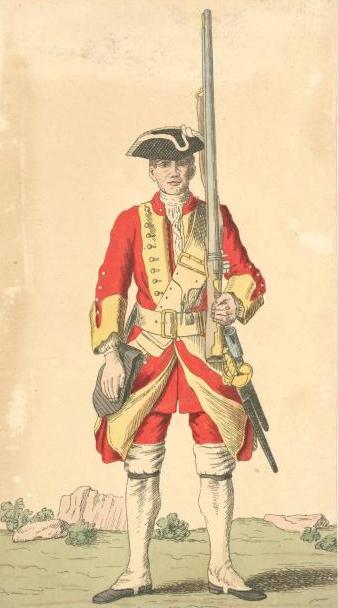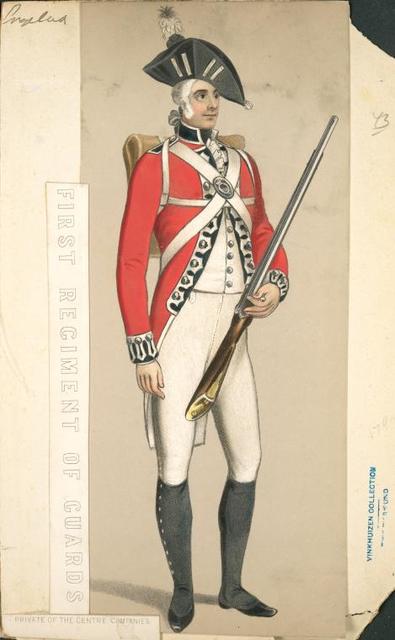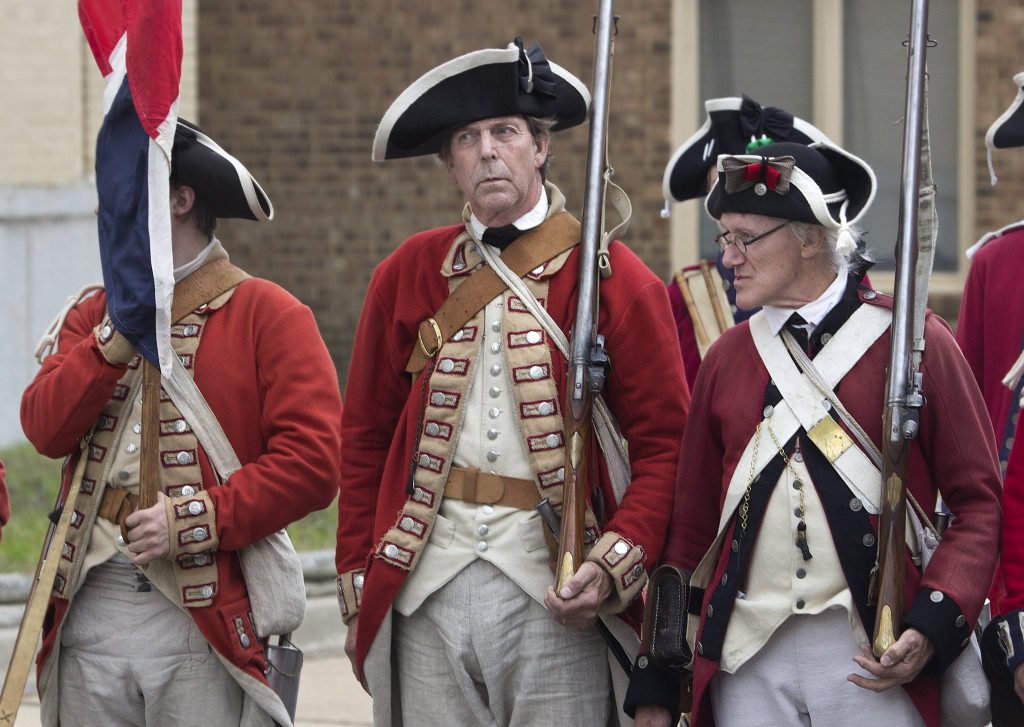Contents
Contents
While American colonial militias used a variety of different uniforms, and their clothing changed as the war progressed, British military garments were generally more consistent.
The British Army was highly concerned with ensuring that their soldiers looked the part on the battlefield. Clothing regulations were passed by royal decree, and they were strictly adhered to where possible. The Redcoats were generally well-supplied when it came to clothing, especially at the start of the war, in stark contrast to the Continental troops.
In this guide, we’ve explained what British Army soldiers and their leaders wore on the battlefield during the Revolutionary War.
British soldier uniform
A British soldier during the Revolutionary War might have looked like this:

Headwear
British soldiers often wore a black felt tricorn hat, normally with a black cockade (a knot of ribbons affixed to the hat, to signify nationality or regiment). Grenadiers would wear bearskin miter caps instead, which looked similar to the hats worn by the King’s Guard in London today, although they were much smaller.
Officers and other higher-ranking officers would also wear their own style of hat. For example, Lord Rawdon, a British lieutenant in the 5th Regiment of Foot, was famous for wearing a cap made of cat fur. Some mistakenly believe that British troops wore a shako during the Revolutionary War, but this type of hat was not introduced until 1797.
Shirt
As a base layer, soldiers would wear a long-sleeve cotton or linen shirt, with a thick, stiff collar to maintain the soldier’s posture. Over the shirt, a red or white waistcoat would be worn.
Coat
The most iconic part of a British soldier’s uniform was their bright red coat. Made of wool, it would have different color facings (the lapels, cuffs, and lining) depending on the soldier’s regiment.
For example, the 3rd Regiment of Foot wore buff facings (a shade of light yellow as shown in the above image) – they were known as the “Buffs”. Blue, green, and other colors were also commonly used. Colored decorative trim, known as lace, was used to signify a soldier’s rank, and epaulettes or wings were used on officers’ uniforms. Above the coat, a white leather crossbelt would be worn, off which the soldier would carry their ammunition box.
Lower body
British Army soldiers would wear white or cream-colored breeches, which were a type of pant that extended just past the knee. Below the knee, black or white gaiters would be worn, made of stiff canvas, to protect the lower leg and prevent dirt and debris from entering the soldier’s shoes. Leggings would also sometimes be worn over the calves, especially in winter.
Footwear
Infantry soldiers wore low-cut, black leather shoes, which were secured with a buckle or laces. Calvary would wear knee-high leather boots to protect their legs when riding.
Why did the British forces wear the color red?

Modern armies generally wear brown, green, and other colors for camouflage. From our current perspective, the color choice of the British in the 18th century may seem a little strange.
There are a few reasons why the redcoats (or “lobsters”, as they were also known) wore red:
- Some historians believe that red was chosen to improve soldier morale, because it would not show bloodstains easily when soldiers were wounded in battle.
- Red and crimson dyes were cheaper to produce than many other colors. Red was also easier to use in bulk, as it did not require mixing many different colors of dyes to produce.
- In 16th and 17th century battles, when British Army red first began to be used, being able to distinguish your comrades on the battlefield was equally as important as being able to stay hidden from the enemy. Some may have considered wearing bright red to be an advantage in many combat situations, as it helped to avoid friendly fire incidents. In addition, during the American Revolution, and in other wars where muskets were used, battlefields were often very smoky. This made it difficult to see the enemy at long range a lot of the time, no matter what they were wearing.
What was this uniform like to wear?

British Army uniform during the American Revolution was warm, and often uncomfortable to wear for long periods.
By the time they finished getting dressed, a British soldier would be wearing three layers, including their thick, woolen coat. In addition to this, they would have to carry a musket, ammunition, knapsack, water canteen, and also a sword, if they were an officer.
As a result, British soldiers sometimes suffered from heat exhaustion, especially when marching during the warmer months.
Even in cool weather, this uniform was far from comfortable. The breeches and gaiters were very tight-fitting, and the stiff collars used were uncomfortable to wear for long periods. The use of wool in garments such as the coat and waistcoat also made the uniform itchy, which was very unpleasant.
Only officers and higher-ranking soldiers got a slight reprieve – they were able to buy custom-tailored clothes that were looser-fitting, and more comfortable to wear over long periods.
Variation throughout the war
Although the British kept using their iconic red coats throughout the Revolutionary War, some changes were made to help soldiers perform better in American conditions.
- Some units, especially in the south, began using lighter fabrics where possible, to keep soldiers cool.
- British Army uniforms gradually became more simple and less ornate as the war progressed. This was partly due to supply issues, but also because the British had to prioritize their effectiveness in combat, especially after the Battle of Saratoga.
- While red coats continued to be worn by most soldiers, a small number of units began to adopt colors such as green and brown for better camouflage in forests and fields where battles were taking place.
By and large though, nationalistic attitudes prevailed, and the British did not make significant changes to their soldiers’ uniforms to make them more suited to conditions in the New World.
It was thought that maintaining soldier morale and intimidating the enemy with striking, ornate uniforms was of greater importance than keeping soldiers agile and comfortable on the battlefield.
Also, the British Army faced logistical issues keeping their units supplied from across the Atlantic as the war dragged on. Even if high command decided to forgo tradition and make wholesale changes to soldiers’ uniforms, which was highly unlikely, completing this change would have proven extremely difficult from a logistical perspective.

